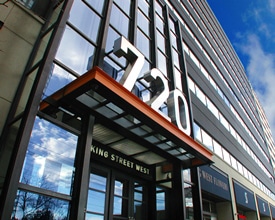720 King Street West, Toronto
Toronto, Ontario
November 17, 2020
- Rating System/Standard
- LEED v1
- Certification Level
- Gold
- Building Type
- Office
We spoke to Alan Murphy, BES, BArch, MRAIC and LEED AP BD+C from Green Reason – the company which acted as the LEED Consultant for 720 King Street West, which earned LEED Gold for Operations and Maintenance. We discuss how they helped raise the sustainability bar for this office building originally built in 1973, the benefits of renovating and existing building to meet LEED standards, and how they got building tenants involved in the process.
Project Team
- Project Owner/Developer
- GPH, on behalf of HOOPP & Shell Canada Pension Trust
- LEED Consultant
- Green Reason Inc.
- Mechanical Engineer
- ESTI Consultants
- Project Manager
- Green Reason Inc.
- Commissioning Authority
- JLSR Engineering
- Other
- Property Management: Triovest Realty Advisors Inc.
About 720 King St. West
720 King Street West is a ten storey, 350,000 square foot office building at the corner of King Street West and Bathurst Street in trendy King West Village. The building has a mix of large tenant spaces and smaller ones, including office and ground floor retail and restaurants.
Originally constructed circa 1973, the building was redeveloped in phases between 1998 and 2001. This renovation of the building changed its original use of light industrial to commercial Class A office occupancy. The building has since undergone many interior renovations accommodating tenant requirements.
Why LEED certification?
The building had been previously certified under BOMA but the ownership and management team recognized that the market appeared to be shifting. The team was aware that many triple A class buildings, both new builds and existing, in the Toronto core were targeting and achieving LEED, and surmised that LEED might also take hold in the class A market. Although the 720 King Street West was almost fully occupied when the decision was made to pursue LEED, it was anticipated that a LEED certification might be beneficial in upcoming leasing as an attractive feature which would help keep the building competitive.

What drove the project?
Key members of the project, some of whom had been involved with the building since the redevelopment, had both an excellent understanding of the building and its operations, as well as a long-time commitment to sustainability. The overall awareness level meant that there were green features already woven into the operations and maintenance programs, which meant a solid base was already established from which to build the LEED EB: O&M certification.
What value does LEED certification bring?
Concurrent with the LEED certification, a tenant green council was created in the building. The council has been a great success with excellent commitment from the tenant team. A new model of interaction has been established where property management and tenants work more collaboratively, including on projects that are not directly related to sustainability but seem to have grown out of the relationships created by the green council.
While the green council supported the building’s LEED certification, it also contributes to ongoing tenant CSR activities and has created an atmosphere for tenants to become more aware of opportunities to improve both the building as a whole and their own suites.
Tell us about specific performance goals.
If yes, what were they are why?

Since this was an existing building certification, the project team agreed that the goal for certification should be based on investments in improving operations – not on capital investments to achieve points. The initial goal of LEED Certified reflected this philosophy. At the time of the initial gap analysis the building was commencing on a 10-year capital improvement plan to upgrade systems as they were approaching end of life.
The project team agreed that rather than accelerate any of these programs to enhance a certification all decisions would be based on the best long-term investment for the building. Instead, the team focused on understanding the opportunities offered by adapting operating policies and programs to the LEED rating system requirements to continually improve the building for the owners and the tenants.
Tell us about results.
Although not specifically created for the LEED certification, the building ownership team working with Triovest and Green Reason established energy reduction targets of 2% per annum over five years commencing in 2011.
After completing two separate rounds of retro-commissioning and implementing a series of low cost/no cost recommendations, the building is on track to hit its energy reduction targets. This landlord program is being enhanced by the efforts of the green council to identify opportunities to reduce unnecessary energy use within suites.
How has certification impacted tenants?
How is this being measured?
Although data on health is not specifically being collected, the building’s Indoor Air Quality (IAQ) testing indicates that measures prompted by LEED requirements have eliminated some previous IAQ issues that had been an ongoing concern. This is expected to improve occupant comfort and satisfaction in the affected areas of the building.
Tell us why this project matters.
This project is remarkable in that it far exceeded its original certification goal of Certified and earned a Gold certification. The building made very little capital investments but strategically lowered water and energy consumption through low cost measures.
The building also gained several credits through tenant participation facilitated by the green council, which consisted of the building management and operations team from Triovest, all major tenants and some smaller tenants, and the building’s sustainability consultant, Green Reason. The team felt this tenant participation was key to the project’s remarkable success.